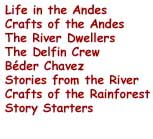

|
Friday, November 24, 2000 San Martin Village
Last week we took the Mirón Lento to the lake outside the village. In just a short week, however, the water level dropped over half a meter. The captain didn't want to risk getting our boat stuck in a shallow spot in the lake so instead, we headed for the lake with our gifts for the school in the skiff, Mango.
It turned out that the art teacher was at a conservation workshop in another village and the students were studying independently. We were an interesting diversion for them. In the classroom, Enzo and Tamara acted as interpreters as we asked questions of the students and they of us. They were very polite but very shy. One of the students sang us a song in Cocama, her native language, then again for us in Spanish. All students at the school study Cocama. For many of the students, this is their native language and the village wants to keep the language "alive." As we were about to leave we asked if they had any more questions for us. One very clever young lady asked us to sing a song in English. The question caught us off guard and we looked at each other in horror realizing that there was no way out. We were going to have to sing! The question was, "What on earth did we all know all of the words to?" Tracy quickly saved us by suggesting we sing "The Itsy-bitsy Spider"—complete with hand motions. After a quick "review" of the lyrics we launched into song. Everyone laughed and applauded when we finished. We were certainly embarrassed but laughed with the students. Of all the things we thought we might do when we woke up this morning— standing in front of a group of school children singing "Itsy-bitsy Spider" was not one of them. Our guess is that they had not imagined the morning as such either. As it turned out, the students were about to be dismissed to release the baby turtles that they had hatched. Students at the school learn about forestry and preserving the resources of the Reserve where they live. The turtle release is going to become an annual event at the school.
Unfortunately, in order to keep to our schedule, we had to leave before the guests arrived. Before we got back into our skiff, we enjoyed watching the younger children crowd around the buckets of turtles and marvel at them—just as we had done when we first saw them at Ranger Station 2 the week before. Río Marañón Despite the low water level, the captain managed to get the Mirón Lento though the narrow channel between the Samiria and Marañón Rivers shortly after lunch this afternoon. Just as we had done earlier on Mango, everyone stood in the bow of the boat as Captain Antonio carefully navigated between the sandbars. At one point the depth gauge registered only half a meter clearance. Over the past week, we have joked about what we would do if we got stuck in the sandbar and couldn't get the boat back to Iquitos until the rains came and raised the river. While it certainly would have been another adventure -- we were glad we made it through. We cheered the captain when we were safely on the Marañón. Leaving the black water of the Samiria and entering the white water of the Marañón was bittersweet. We are anxious to get back to the comforts of home, but are sad to leave the Reserve. Once on the Marañón, the river widens and becomes much deeper. The current is also much stronger, so the boat is moving almost twice as fast as when we were on the Samiria. Our dolphin count has changed dramatically. Do you think that we saw more or less dolphins in the deeper white water? Check our daily data and compare it to data from the past week to see the change in numbers. Why do you think there is a difference? We will spend the night just this side of Nauta where we first boarded the boat almost two weeks ago. In the morning we will stop in Nauta and return our empty beverage bottles in exchange for the money we left as a deposit on the bottles. We will most definitely buy ice cream bars even though it will be early morning. Safe Haven for Machina Horacio decided last night that he would like to take Machina back to Iquitos with him. Turns out she is a darn good "mouser." When we stopped at Ranger Station 1, Machina's home, he had to barter with the rangers. Since we had extra beverages that we couldn't possibly drink between today and when tomorrow morning, we traded 12 bottles of beverages for Machina. Machina will certainly have an easier life but it may be hard for her to adjust to "city" life. Every night that we anchored by the riverbank she would "jump ship" and hunt the night away. Each morning we just hoped that she hadn't become prey herself during the night. Amazingly, each morning she'd climb safely back on board. Oil Spill On October 3rd of this year an Argentine oil tanker on the Marañón sprung a leak in one of its tanks and dumped close to 8,500 barrels of oil before the leak was stopped. Each barrel holds 55 gallons of oil. We saw clean up crews along the banks this afternoon gathering oil soaked vegetation and putting it in large plastic bags. Bug Free! Only two more nights on the Mirón Lento. It is hard to believe these two weeks are almost over. The time has flown by so quickly. We are taking Saturday off! We will make our final postings to the site on Sunday and Monday when we are back in Iquitos. We are looking forward to those air conditioned, bug-free Internet cafes! |




